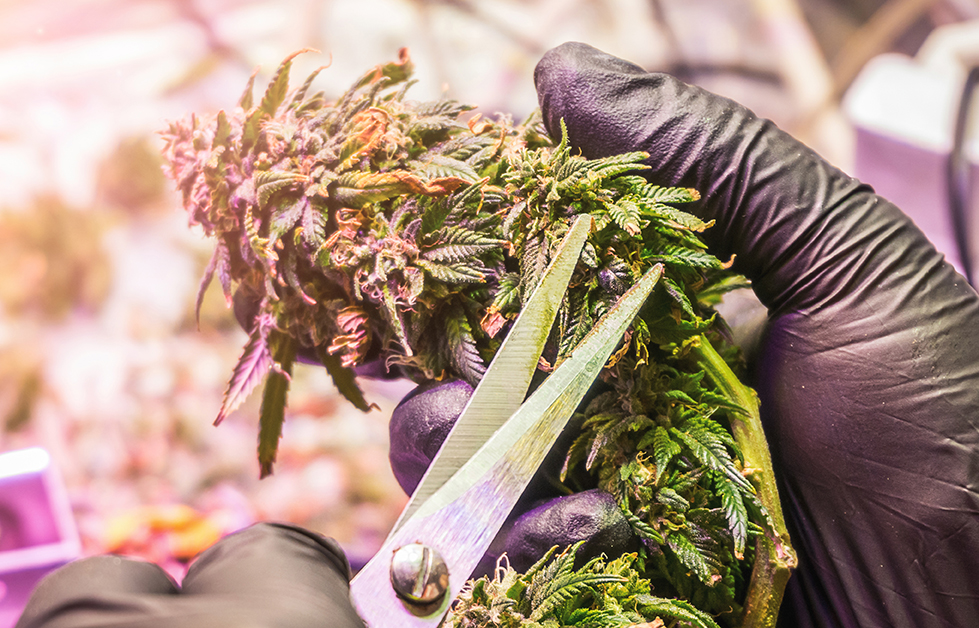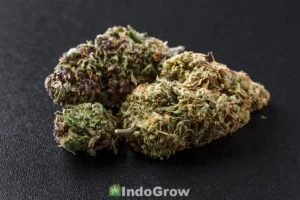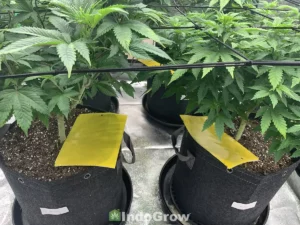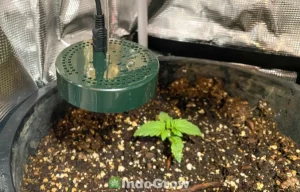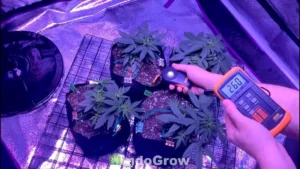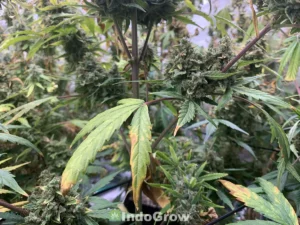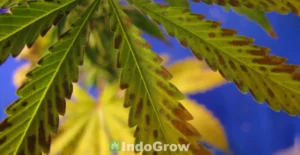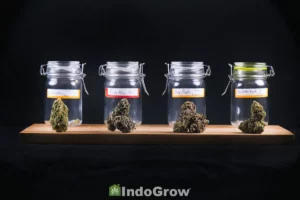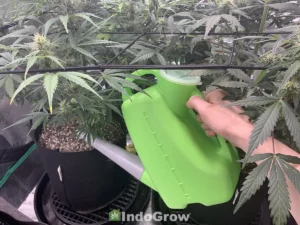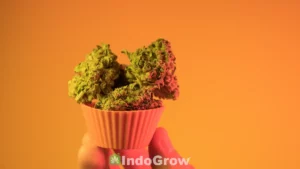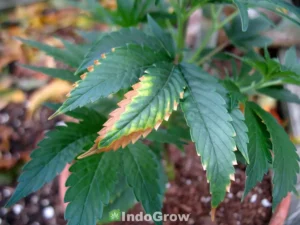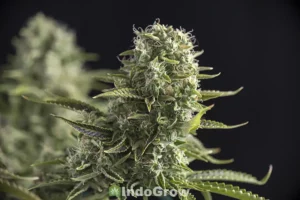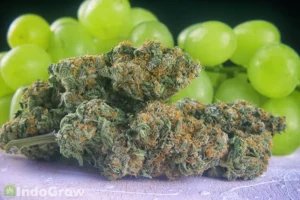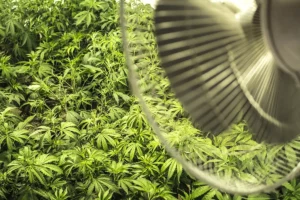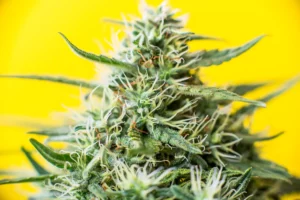After harvest, growers may wonder what to do with weed trim, such as fan leaves, sugar leaves, and popcorn buds. Below, we go in-depth into what trim is, the types of trim, and the multiple uses that can turn discarded leaves and buds into something useful.
If you’re interested in making edibles, topicals, hash, etc. from your trim, then continue to reading to discover just how easy it is.
What is Trim?
Trim is an umbrella term for the parts of healthy cannabis plants that get trimmed off, including sugar leaves, fan leaves, and popcorn buds. The trim is removed from the buds after drying, just before curing.
Though trim may seem like a useless byproduct of your harvest, it often contains the same THC-rich trichomes as your buds. The many possible uses for trim take advantage of these trichomes, including using it as cannabutter or infused oils to make edibles or converting it into bubble hash or dry sift hash for smoking.
Before getting into those uses though, it’s important to distinguish between the three types of trim – sugar leaves, fan leaves, and popcorn buds – and how best to use each one.
Sugar Leaves
Sugar leaves are called that because of their coat of resin-rich trichomes, which shine like sugar. Though sugar leaves are rich in THC compared to fan leaves, they are not as potent as the buds. Additionally, sugar leaves produce a harsher smoke, which is why they’re removed from buds intended for smoking.
Yet, those trichomes come in handy for growers that know how to repurpose sugar leaves for side projects. Despite tasting bitter when smoked, they go down easily inside of cannabutter, cannabis-infused oils, and other edibles.
Fan Leaves
Fan leaves are typically discarded at harvest. Many growers prune fan leaves throughout the grow as well to allow more light and airflow to the lower bud sites. Growers who let their fan leaves run wild often have lower yields due to light deficiencies. They can also allow buildups of moisture around the colas, which can lead to mildew.
Unlike sugar leaves, fan leaves are not rich in trichomes and resin, so their use is more limited. However, they still contain a little THC and can be used as a base for a cannabutter mix that includes both fan and sugar leaves.
By themselves, fan leaves are not particularly useful in edibles, though they are considered a healthy superfood when consumed raw. This won’t lead to getting high, but a clever grower could still make use of them in a smoothie.
Even if you don’t intend to use in recipes, fan leaves can still be used as compost to fuel your next crop.
Popcorn Buds
Popcorn buds are named for being smaller than usual and “airier,” giving them a puffed-up look. They form this way because of light deprivation at the lower bud sites.
This type of bud is less potent and difficult to smoke, so it gets trimmed. However, popcorn buds do contain more THC than any other type of trim. This makes them ideal not only for making cannabutter or infused oils, but also for using in hash and rosin.
Decarbing Trim
Before you decide what to do with weed trim, you’ll need to decarb the buds. Decarbing, which is short for decarboxylation, is a necessary process to turn trim into many of the byproducts that growers can use. Decarbing trim is a process that uses heat to turn THC-A into THC, which is the compound that gives cannabis its mental and physical effects (this is why eating a raw cannabis leaf does not produce much of a high).
The decarbing process is simple, requiring only a normal baking sheet and an oven at 240-245 degrees Fahrenheit. All you have to do is lay the leaves flat on the sheet and bake them for an hour.
Decarbing trim is required to turn it into cannabutter and infused oils, which only work once the THC has been “activated” by the heat. However, it isn’t necessary for hash and rosin since these products will be smoked.
Cannabutter
Cannabutter is a well-known baking ingredient, combining cannabis trim and butter into the perfect base for delicious edibles.
To make cannabutter, growers need a mix of trim that includes at least some sugar leaves and popcorn buds. They can fill out the rest with fan leaves for volume, though using fan leaves in cannabutter will produce a less potent recipe.
After collecting a mix of trim and decarbing it, it needs to be combined with normal butter (4 cups for every ½ cup of trim) and water (8 cups for every ½ cup of trim). Add the ingredients to a pan and simmer for several hours (at least 4), with occasional stirring.
Alternatively, you can put the decarbed cannabis and butter in mason jars and heat them in a hot water bath for a few hours. This keeps the water separate from the cannabis and butter, but I’m not sure if it makes much of a difference.
After taking the mix off the heat, let it cool. It then needs to be strained through a cheesecloth lined in a colander over a bowl. To get the most from your mix, use a spatula or spoon to push the leaf mixture into the cloth.
Once the cannabutter has been strained, it should be refrigerated until it firms up. After that, it can be used like butter in a 1:1 proportion in any of your favorite edibles.
Infused Oils
Decarbing trim can also be the start of an infused oil recipe, which is another great way to add cannabis effects to your favorite edibles. Most oils can be infused, including canola, coconut, olive, vegetable, or sesame. This can be done with a mix of sugar leaves, popcorn buds, and fan leaves (if desired).
Once chosen, heat the oil and cannabis in the same proportion in a saucepan or slow cooker. The mixture needs to simmer for 2-3 hours on low, ideally not going over 200 degrees or below 160 degrees.
After that, the oil needs to be strained through a cheesecloth or mesh into a bowl. For oils, it’s important not to squish or squeeze the leaves as this can alter its taste. Let the mixture pour through naturally and let the result completely cool before bottling or using it as a replacement for cooking oils in your edible recipes.
Bubble Hash
Bubble hash is also made from trim consisting of a mix of sugar leaves, fan leaves, and popcorn buds. It’s named “bubble hash” because it often bubbles after being lit.
Making bubble hash requires decarbed trim and ice water, mixed in a vinyl “bubble bag.” Bubble bags strain the resins from the trim, separating them from the plant material. The bags should be layered in a 1-5-gallon bucket in order of the smallest filter size to the largest. Then, fill the bucket halfway with ice water.
The trim can then be added until the bucket is full, stirring with a large spoon or ladle for up to 20 minutes. The filter bags will gradually collect trichomes from the trim, which can then be strained from each bag and used as bubble hash.
Dry Sift Hash
Dry sift hash begins with a similar mix of trim made from sugar leaves, fan leaves, and popcorn buds. The trim is then frozen for at least 24 hours.
A screen box or a special container called a “hash shaker” is needed for the next step. The frozen trim is placed in the box and moved from one side to the other until the trichomes flake off. This can be done with a wooden object or even with gloved hands.
Afterward, the dry sift hash will be at the bottom of the box and can be scraped off and smoked without needing to be cured.
Rosin
Unlike the previous uses, rosin requires popcorn buds to make. Creating this concentrated, flavorful extract requires a special device called a rosin press.
Rosin bags, which are made from screen mesh, are filled with the popcorn bud trim and then pressed (you can use your hands) to soften and evenly distribute them. Then, the bags can be loaded into the rosin press, which uses pressure from heated plates to press the bag and extract the rosin.
The press only needs around 1-2 minutes to press out the rosin, though you can do it for longer if the bag is still yielding results. Rosin should be obtained only once the plates have reached around 180-220 degrees and at a pressure between 1000 and 2000 PSI.
Other Ways to Use Cannabis Trim
Cannabis trim can be used in ways other than those already mentioned. Infused oils, besides their cooking utility, can be used to make tinctures, creams, and salves. These products are easily absorbed into the user’s skin and often come with many of the same benefits as cannabis, including pain, stress, and inflammation relief.
Additionally, raw trim leaves can be used as herbs in pizza and other dishes or blended into healthy smoothies. Even low-quality trim unfit for these products can be used as compost for future cannabis crops. This adds nitrogen and other essential compounds to the soil, potentially increasing your yield.
Conclusion
After a crop has been trimmed, many cannabis growers wonder what to do with weed trim. Cannabis leaves leftover from a good harvest do not have to be wasted.
There are many uses for cannabis trim, including cannabutter, oil infusions, salves, compost, rosin, bubble hash, dry sift hash, and more. The potency of the product depends on the mix of trim used and the process of making each mixture.

Rocky Horton
Author
Rocky Horton is an experienced cannabis grower and the founder of IndoGrow. The IndoGrow editorial team has over four decades of combined growing experience. Learn more.

